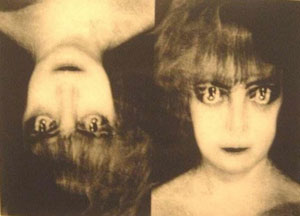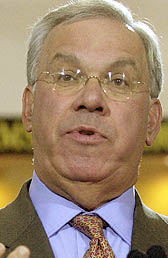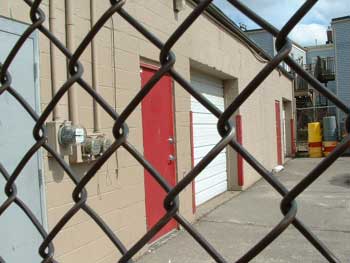LET ME BEGIN BY ASKING YOU WHAT YOU’RE UP THESE DAYS. I UNDERSTAND THAT YOU RECENTLY CLOSED ELIAS FINE ART IN ALLSTON AFTER SIX YEARS AND THAT YOU TURNED OVER YOUR POSITION AS HOST OF ANTIQUES ROADSHOW AFTER THREE YEARS TO LAURA SPENCER FROM ABC – HAVE YOU DISCOVERED FREE TIME OR ARE YOU PURSUING OTHER PROJECTS?
DE: I closed the gallery to move into museum work. I have always, and increasingly, been interested in why people make what they make, and how an idea becomes a thing in the hands of an artist/artisan. I apply that to new objects as well as old ones. That focus is, I came to realize, not a commercial focus, but more of a museum/academic focus. I am in the Master's in Museum Studies program at Harvard Extension Division, which is a kick (back to school, age 46? Yikes!), and looking hard for an entry into the museum world. I want to run one someday.
IF I REMEMBER CORRECTLY, YOU STUDIED STUDIO ART AT THE SCHOOL OF THE MUSEUM OF FINE ARTS IN THE MID 1980’S, SO I ASSUME YOU WERE TRAINED AS AN ARTIST – CAN YOU TELL US ABOUT YOUR EXPERIENCE THERE? WHAT LED YOU TO STUDY ART AND AT WHAT POINT DID YOU REALIZE THAT YOUR INTEREST IN TALKING / THINKING ABOUT ART AND YOUR ROLE OF ADVOCATE WAS MORE SIGNIFICANT THAN YOUR OWN ARTMAKING?
DE: I left school after high school, went out and worked for eight years at lots of things, started the New Ehrlich Theater at the Boston Center for the Arts with a friend (I was tech director and set/lighting designer). Tired of the supremely collaborative nature of theater, and more interested in building things, I entered the Museum School. After a couple of years I decided to get the degree, spent a year at Tufts, and finished with both degree and diploma. I found I didn't have the single-mindedness necessary to be an artist, nor the confidence in my own statements without which an artist can't exist, since success is so tough to come by and takes so long. I realized that, unlike many other people, I was able to use words to accurately and engagingly talk about works of art, and had a facility for looking. I liked making things, but knew there were many others more talented than I who would never get anywhere, and I should stick to what I did best.
YOU’VE BEEN DEEPLY ROOTED IN THE ART COMMUNITY OF BOSTON FOR ABOUT TWENTY YEARS NOW; FIRST WORKING WITH A THEATRE GROUP AT THE BOSTON CENTER FOR THE ARTS, THEN AS DIRECTOR OF BARBARA KRAKOW GALLERY AND EVENTUALLY OPENING YOUR OWN GALLERY – CAN YOU OFFER YOUR PERSPECTIVE ON THE ART SCENE HERE?
DE: Oh boy, here we go.
There are four factors which, I believe, are paramount in determining the peculiar shape of the Boston contemporary art community.
1) There are many, many more people interested in making than in buying. Boston has tremendous intellectual, historical and even financial riches, but people here tend to see themselves as producers rather than consumers of culture. This is true not only among the art community: the Nobel prize winners across the river, the high-priced lawyers and the financial managers tend to feel the same way. People chase them, they don't chase people.
2) Serious collectors, and even many who are only dabbling, prefer to go to what they perceive as the sources in New York, Europe, LA and the art fairs to do their shopping. Discounts tend to be more important than quality and checks made out to non-profit institutions buy more for less, through a, perhaps willful, misinterpretation of the tax laws.
3) I also believe that the contemporary art world has shot itself in the foot to some degree. We rely on white walls, a hushed tone and either a famous name or designer colors to sell our work for us. We have not been nearly friendly and accessible enough in our efforts to present exciting, challenging, brilliant work, and to tell the stories about why people should care. We have also neglected to put work into the national and international mainstream, although much of that is economic: There is insufficient capital available to rent booths in art fairs at $10,000 a pop.
4) The institutions have been asleep at the switch. While Warhol, Johns, Beuys and Richter were affordable; the MFA was buying every Morris Louis it could get its hands on. David Ross, for all he was in many ways a brilliant director for the ICA, had a deep conviction that one should not have to persuade people about the value and meaning of contemporary work. It was the esthetic equivalent of the famous JP Morgan comment about yachts: If you have to ask, then you can't understand it. That was a deeply damaging idea to us and we're still suffering for it. This, I am glad to say, is changing rapidly. With the tenure of Bill Arning, with the inception of a department of Modern and Contemporary Art at the Fogg, with a great new team installed at the Davis Museum, and a succession of charismatic, well-spoken curators at the ICA, not to mention a world-class project at the Gardner, of all places, the institutional picture has brightened considerably. Now it's a question of how long it will take to have an effect.
WHILE YOUR GALLERY WAS OPEN YOU SHOWED AN AMAZING GROUP OF BOSTON-BASED ARTISTS, ARGUABLY THE BEST IN THE CITY – TAYLOR DAVIS, FRANK EGLOFF AND ALICE SWINDEN-CARTER AMONG OTHERS. CAN YOU TALK A LITTLE ABOUT THE IDENTITY OF YOUR GALLERY, HOW DID YOU DECIDE WHOSE WORK TO SHOW AND WHAT WERE YOU
LOOKING FOR IN THE WORK OF POTENTIAL ARTISTS? DID THE NEED TO SUPPORT LOCAL AND REGIONAL ARTISTS FIGURE INTO YOUR DECISIONS?
DE: Thanks for the compliment. I enjoyed putting it together.
My theory for selecting artists is very simple. I want it all. I want an artist to produce work, which has been thoroughly considered, from top to bottom. I want a marvelous, memorable visual impression, and a rich, satisfying set of ideas to back it up (sounds like a beer commercial, doesn't it?). I want to be able to think about an individual work for a long time, and then when I see another piece by the same person, I want to be surprised and pleased by the new ideas and connections they have shown to the earlier work that I couldn't have made myself. I want them to work hard, and think about everything -- all the time. Take responsibility for every aspect of the experience they are giving the viewer, and not require the viewer to do the work. The viewer has other tasks to attend to.
As to local versus non-local, I refuse to draw the distinction. I think as a matter of philosophy that everyone should be considered, but I am going to stack them up against Sigmar Polke and Richard Artschwager and Charles Long and just let them slug it out. The notion that we must preferentially show local artists results in an esthetic defined by negative example: It can only be good if it is not like the major leagues. It results in the valorization of the left-behind. That's hogwash. What we must do is preferentially look at local artists, because if we don't, who will?
I AM REMINDED OF A FREQUENT OCCURANCE DURING MY TIME AS A MUSEUM GUARD – VISITORS WOULD OFTEN ASK “WHERE IS THE MOST VALUABLE PAINTING AND HOW MUCH IS IT WORTH?” A PARALLEL WOULD PERHAPS BE THE LITTLE TREASURE CHEST GRAPHIC AND “CHA-CHING” THAT REVEALS THE MONETARY WORTH OF THE APPRAISALS ON THE ANTIQUES ROADSHOW (SOMETHING THAT I UNDERSTAND ISN’T INCLUDED IN THE BRITISH VERSION OF THE PROGRAM). ASSUMING THAT AMERICAN CULTURE EQUATES MONETARY VALUE TO THE OVERALL WORTH OF AN OBJECT, DO YOU SEE A NEED FOR ANOTHER SET OF CRITERIA BY WHICH TO EVALUATE HISTORICAL OBJECTS? WHAT MIGHT THESE GUIDELINES BE?
DE: There are many ways to value an object. Money is really, really easy to understand, at least on the surface. As noted before, we have generally done a poor job of explaining the other dimensions of importance, and so people have to rely on what they have to work with. The irony is that an article has value because of a marketplace. A marketplace by its nature is fluid, worth more today, less tomorrow. Therefore, the monetary value attached to an object is, in many cases, the least permanent aspect of it. The history goes on and on, the theoretical importance, the stories, all of it just keeps getting longer and richer with time, but the money goes up and down based on the whim of the market (which if supply and demand is anything to go by, is just two people finally battling it out at the end. How thin can you get?)
CONTINUING WITH THIS LINE OF THOUGHT, HOW ARE WE AS A CULTURE TO EVALUATE CONTEMPORARY ART OBJECTS? GIVEN THE FACT THAT RIGOROUS TECHNICAL SKILL SEEMS TO BE ALMOST NONEXISTENT IN CONTEMPORARY ART, WHAT CRITERA SHALL WE USE? IT WOULD APPEAR THAT THE CRITERIA USED BY THE APPRAISERS ON ANTIQUES ROADSHOW IS IN DIRECT OPPOSITION TO THE CRITERIA NEEDED TO DEAL ART FROM A CONTEMPORARY GALLERY – DID YOU EVER FIND YOURSELF GRAPPLING WITH THIS CONTRADICTION?
DE: Nonsense. The criteria are the same. Contemporary art and antiques are the same thing. People value things because they enjoy them. The more people with money to spend that enjoy something which is in limited supply, the higher the price will be. Quality of construction has very little to do with it. The effectiveness with which someone has captured the moment in which they live, and the essence of some aspect of reality which others experience as well, is the only commodity really worth anything in any esthetic marketplace. That is not to say that quality of construction is not important. It is, but in a larger sense: It has to be built in a way, which is appropriate to the conceptual task. Sol Lewitt's 1960s instruction drawings were typescript on paper -- absolutely appropriate to the idea. If they had been engraved on gold tablets, they would have become something entirely different, and not nearly as clear. Your construction has to be so good that every aspect of it reflects and intensifies the reason to make the piece in the first place.
IT WOULD SEEM THAT ANTIQUES AND CRAFTS TEND TO BE TIGHTLY CONNECTED TO REGION – DO YOU BELIEVE THERE IS A REGIONAL AESTHETIC IN THE MODERN AND CONTEMPORARY ART MADE BY THOSE LIVING IN NEW ENGLAND?
DE: On the contrary, antiques and crafts are categorized by region, but they occur all over, and are all mixed up by the movement of owners. During Antiques Roadshow, we saw a great French 19th c. tea service in Texas that had been commissioned on a Grand Tour by a 19th c. cattle baron. He had brought silver dollars in a chest from the US, silver probably mined in Colorado, to be made up into a tea set. So that was at once French and Texan. Go figure. A great 18th c. Salem, Massachusetts chest in Tulsa, a scrimshaw whale's tooth from a Nantucket whaling captain's family in Tucson, a 7th c. Chinese marble lion in Albuquerque.
Several years ago there was a cover story in the NY Times Sunday Magazine, showing 40 hot, new, up-and-coming artists from the New York scene. By my personal count, 26 of them had been born, raised or educated in the greater Boston area. So look at ArtForum, or any other major art magazine or art fair, and you can see the 'Boston Esthetic' at work. Anything else is the leftovers. We did a panel at the gallery consisting of my artists during a Boston Art Dealers Association Boston Art Month or something, called "Is there geography in the Art World?" The upshot was that there is not.
- Oscar Palacio; Bridge, 2000; C-print. Courtesy of the artist and Mass College of Art
- Taylor Davis; Palatte, 2003; Wood & mirrors. Courtesy of the Gallery @ Green St.
- Frank Egloff; After Man Ray, 2001; Acrylic on canvas. Courtesy of Brent Sikkema Gallery, NYC.
Links:
Antiques Roadshow
Frank Egloff image is courtesy of Brent Sikkema Gallery, NYC. Taylor Davis image is courtesy of the Gallery @ Green St., Boston. Oscar Pallacio image is courtesy of the artist and Mass College of Art.
C. Sean Horton is the editor-in-chief of Big, Red & Shiny.






